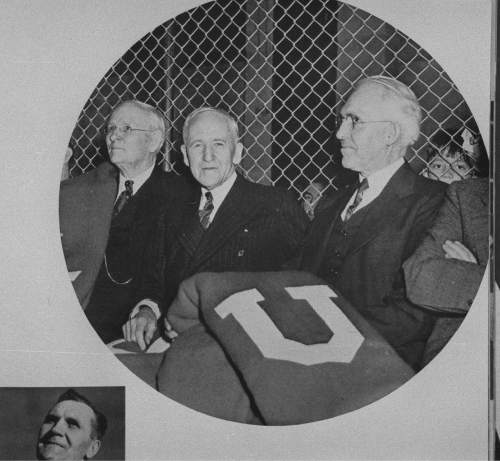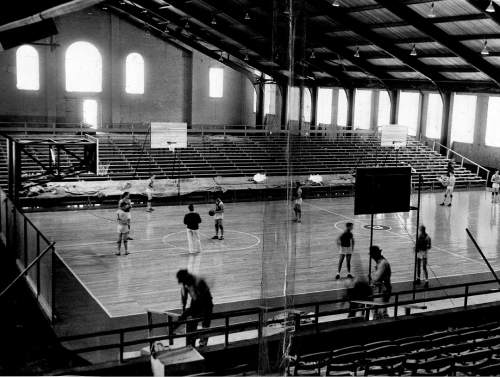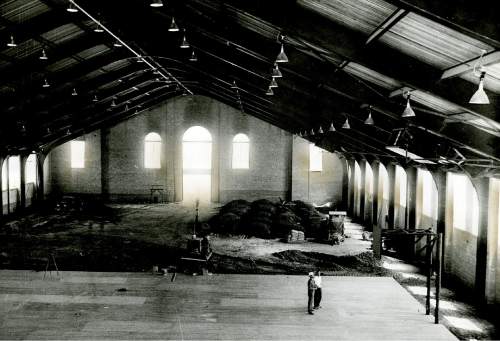This is an archived article that was published on sltrib.com in 2016, and information in the article may be outdated. It is provided only for personal research purposes and may not be reprinted.
Editor's note • In this regular series, The Salt Lake Tribune explores the once-favorite places of Utahns, from restaurants to recreation to retail.
—
At a time when the University of Utah continues to upgrade its athletic facilities, it's difficult to realize that as late as 1969, the Ute basketball team played in a glorified barn.
To remember that, attend a game at the upgraded and modern Rice-Eccles Stadium and look just north — to a tan brick building with UTAH spelled out on its roof.
That's the Einar Nielsen Fieldhouse, which gave the Runnin' Utes an incredible edge from its opening in 1939 to its last game in 1969.
"Talk about a home court advantage," said former Ute great Kenny Gardner, who won a state high school championship at the old barn with Clearfield in 1967 and played the final season at the field house in 1969.
"Those other teams didn't have a chance. The fans were so close to the floor," Gardner said. "There were two big fences on either end under the hoops. The fans were so enthusiastic and supportive, they would climb the fences and shake them."
There were two chain-link fences under the baskets, where the few hundred general admission seats were located — and were sometimes available in the usually sold-out arena with a capacity of around 5,600. In his book on the history of U. basketball, Jason Hansen told the story of Jim "The Animal" Dailey, who would climb up one of the fences and pound it hard to cheer for his team.
Salt Lake Tribune sportswriter Bob Williams called it the "hilltop house" when he covered one of its biggest games, held on Dec. 21, 1959. The Runnin' Utes beat second-ranked Ohio State and stars Jerry Lucas and John Havlicek 97-92. Billy McGill, the Ute star, scored 31 points and grabbed 17 rebounds. The game drew 5,910 fans, way over capacity.
Longtime Tribune sportswriter Dick Rosetta remembers covering many high school state tournaments at the multipurpose building, which also held offices for the athletic department. He said he met legendary Ute tennis coach Harry James and Athletic Director James R. "Bud" Jack in those offices.
Rosetta remembers the building as often hot and humid, with dust from the area behind the temporary bleachers often swirling up to cover notebooks. There were tussles in the stands, with high school students jumping up and down so hard that the press box at the top often swayed.
"We outgrew it for sure," said Gardner, who moved with the team to what is now the Jon M. Huntsman Center in 1970. "I loved that arena because, back in my day, we played the state tournament there. In 1967, my Clearfield team took state. Highland took state in '65 and '66, and it was so impressive to look across stands full of [the school colors] black and white … the whole place would rattle and shake."
Gardner played in the final college game at Einar Nielsen on Feb. 22, 1969. Mike Newlin scored 37 points as the Utes beat rival Brigham Young University 98-85.
"It was like putting away an old baseball glove," said Newlin, one of many Utes who would go on to play professionally after their stint at Einar Nielsen.
According to J.D. Davis, who wrote about the field house in 1999 for the U.'s Continuum magazine, the building was named for Einar Nielsen, who served as the men's athletic trainer at the U. and as the masseur at the old Deseret Gym in downtown Salt Lake City.
The building opened in 1939 and cost $175,000. According to the U.'s Historic Buildings site, it was to be used for physical education and the ROTC. It was the largest building on campus at the time.
Temporary stands could be removed so football practice could be held indoors. The field house was turned into a dormitory for 1,000 soldiers in 1943 at the height of World War II. The bleachers and basketball floor were stored in the balcony.
While the outside of the building has changed little through the years, the inside served as a fitness center for students, faculty and alumni for many years.
Now, according to Matt Yurick, director of the U.'s space planning and management, the building houses a chilled water plant that serves about a third of the campus.
It's likely to have a future academic use, but safety code updates will be needed if it will be used by students or the public, and there are no specific plans, Yurick said.
So players such as Gardner, sportswriters such as Rosetta and the dwindling number of fans who watched a game in the old barn will continue to remember the Einar Nielsen Fieldhouse as the former home of the Runnin' Utes.
—
If you have a spot you'd like us to explore, email whateverhappenedto@sltrib.com with your ideas.
Twitter @tribtomwharton







